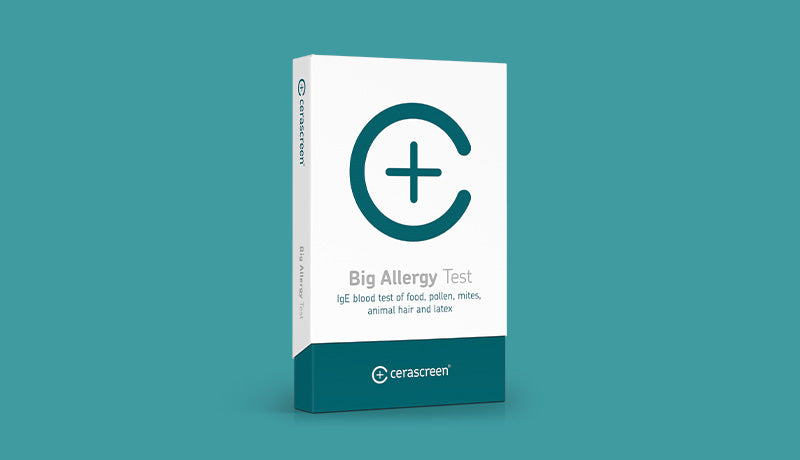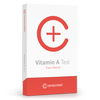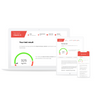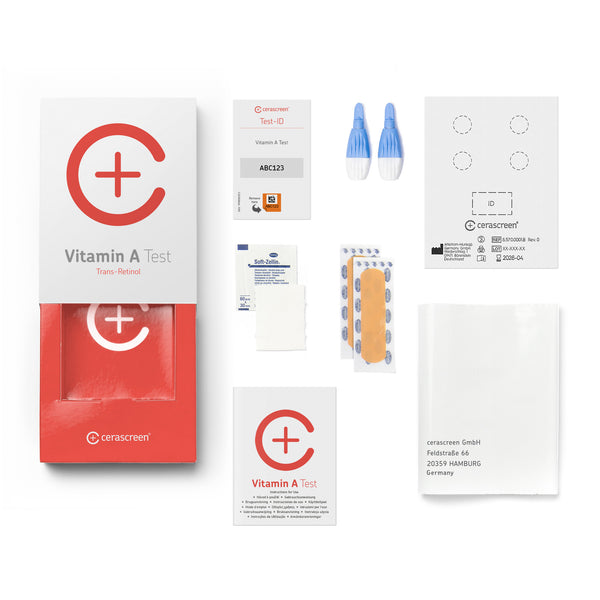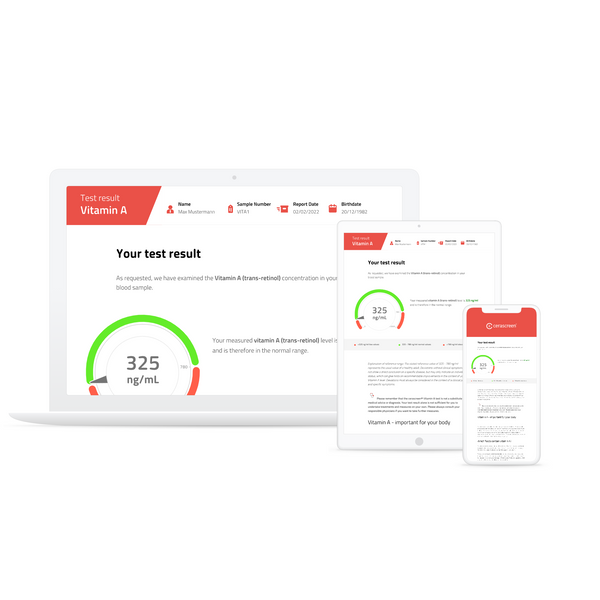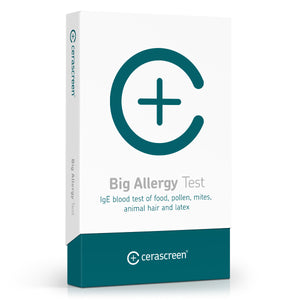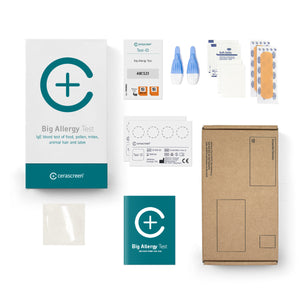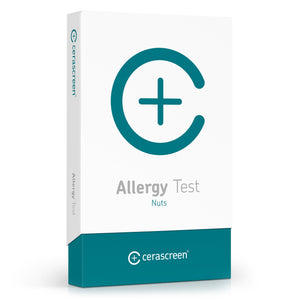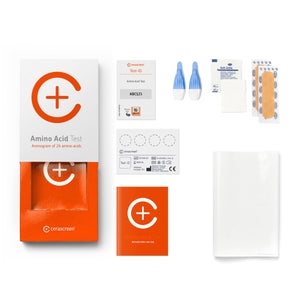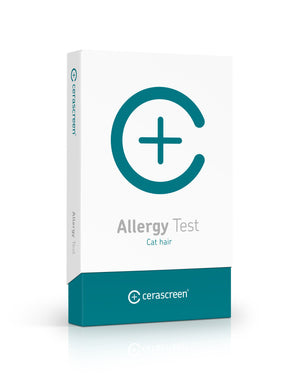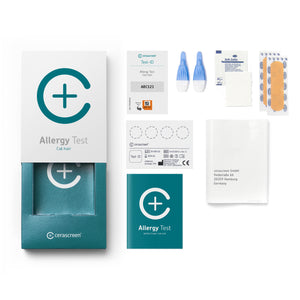product_id = 7991183081739variant_id = template_name =
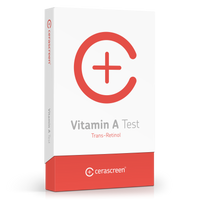
Vitamin A Test
Measure vitamin A levels
About the test
A vitamin A deficiency can lead to vision problems, frequent infections and anaemia, for example. A first symptom is often night blindness, i.e. problems with seeing in dim light. Too high a vitamin A level is also problematic and can cause liver damage, among other things.
Test now whether your blood values indicate an over- or undersupply of vitamin A. The cerascreen® vitamin A test is a home sampling and submission kit. In the laboratory, the level of vitamin A (trans-retinol) in your blood is examined.
Vitamin A Test
- Take your sample at home – conveniently and discreetly
- Receive a state-of-the-art laboratory analysis
- Benefit from specific recommendations to improve your intake of vitamin A
- Receive the result within a few days after your sample’s arrival at the laboratory
Benefits of the Vitamin A Test
A vitamin A deficiency, but also an oversupply, can lead to complaints and increase the risk of disease. If you recognise early on that your vitamin A level is out of balance, you can actively take countermeasures. With a blood test you can better assess and optimise your supply.
You take your sample for the cerascreen® vitamin A test at home: without hours of doctor's visits and waiting times! The test is a blood test: a small prick in the finger is enough. The analysis takes place in a specialised medical laboratory.
Benefit from our expertise: cerascreen® is the market leader for medical sampling and submission kits in Europe, with 9 years of experience in test development and evaluation. We have developed more than 60 approved send-in test kits (medical devices), evaluate 250,000 samples per year and are available in many European countries.

Result of the Vitamin A Test
As soon as your sample has been evaluated, you will receive your results report via the my cerascreen® app or in the user account of our secure online customer area. You can easily view the report on your smartphone, tablet or computer and read it in printed form if required.
The laboratory analysis will tell you the concentration of vitamin A in your blood and whether the level is within the reference range. Learn how to improve your vitamin A levels through diet and supplements with our recommended actions. Comprehensive health information explains what your body needs vitamin A for and how to get it.
Frequently asked questions about Vitamin A Test
Why test for vitamin A?
As with many other nutrients, the right amount of vitamin A is important. Too little of the vitamin leads to a deficiency, too much can cause poisoning. If a vitamin A deficiency persists for a long time, it can even have serious consequences, such as muscle weakness, infertility and blindness.
A vitamin A deficiency can also be an indication of a disease or other health problems. In Europe, such a deficiency is relatively seldom the result of poor nutrition - more often it is caused by impaired fat digestion or an increased vitamin A requirement. The reasons for this can be diseases, injuries, but also stress, smoking or alcohol abuse.
If you recognise a deficiency or an overdose, you can actively counteract it. Sometimes it already helps to improve the vitamin A level through diet and food supplements. However, it often makes sense to visit a doctor to find out the possible causes behind a deficiency and to quickly recognise and treat possible diseases.
Who should take the test?
A vitamin A test can be worthwhile if you have complaints that indicate a deficiency. Typical, for example, is night blindness. Affected people often see poorly in dim light and cannot orientate themselves well at night. You can read more about the symptoms below under the question "How does a vitamin A deficiency manifest itself?
Even if you suffer from diseases that lead to a vitamin A deficiency, a test can be useful - this gives you the opportunity to optimise your supply.
How does the test work?
For the vitamin A test, take a small blood sample from your fingertip with a lancet. Only a few drops of blood are needed for this. Put the drops on two dry blood cards - this way you only have to take a very small amount of blood and the sample will keep for a long time.
The sample is sent free of charge by return envelope to a specialised medical laboratory. The laboratory analyses how high the concentration of vitamin A is and whether they are in the reference range or above. After the analysis, you will receive a notification and can access the results report via the online customer area or the my cerascreen® app.
How long does the analysis take in the laboratory?
Once your sample has arrived at the laboratory, it will be analyzed there by specialists. How long the analysis takes depends on the exact measuring method and the processes in the laboratory.
If the sample is sent on the correct days (Sunday to Tuesday), this makes it easier for the laboratory to adhere to the times.
p>
For the Vitamin A Test, the laboratory analysis is usually completed within 6 working days after the sample is received in the laboratory.
What does the results report tell me?
The test result report tells you what vitamin A level was measured in your blood. The vitamin A level is given in the unit nanogram per millilitre (ng/ml). The exact form of the vitamin that is measured is trans-retinol.
You will also find out whether your test result - compared to the reference values - is in the normal range, or whether it is elevated or low.
What recommendations do I receive?
The result report will tell you the possible reasons why your vitamin A levels might be too high or too low.
We also give you tips that you can use to influence your vitamin A levels through diet or supplements.
What is vitamin A?
Vitamin A is a vital vitamin that we humans need to take in with our food. Among other things, it is important for vision, immune defence, blood formation and reproduction.
Actually, vitamin A summarises a number of substances. The most important of these is retinol, sometimes also called vitamin A1. Retinol is found in animal foods, can be converted into other forms of vitamin A and stored in the body as retinyl esters.
How does vitamin A deficiency occur?
A deficient or one-sided diet can lead to a vitamin A deficiency. However, this is relatively rare in developed industrialised countries.
In Europe, it is more common for people to have a greatly increased need for vitamin A or for fat digestion or absorption in the intestine to be disturbed.
Diseases such as diabetes, hyperthyroidism, inflammatory bowel diseases (for example Crohn's disease) or disorders of the liver or pancreas can be behind impaired vitamin A absorption.
Increased need can be due to, among other things, inflammation, alcohol abuse, many years of heavy smoking, stress, injuries and operations, or very serious diseases such as cancer or AIDS.
How does a vitamin A deficiency manifest itself?
Vitamin A deficiency manifests itself in different ways depending on how long the deficiency has been present.
The first symptoms of vitamin A deficiency can be:
- Dry hair, hair loss, brittle nails
- Night blindness and poorer vision
- chapped lips
- Headache
- frequent infections
If the deficiency becomes chronic, the following complaints can also occur, some of which are very serious, including:
- Going blind
- Dizziness and nausea
- Poorer sense of smell and taste
- Horny skin, skin ageing
- Muscle weakness and fatigue
In addition, chronic vitamin A deficiency increases the risk of certain diseases and health problems, for example arteriosclerosis, kidney stones and infertility.
How does a vitamin A overdose manifest itself?
An oversupply of vitamin A is almost always the result of too high a dosage of supplements.
Such vitamin A poisoning can have the following symptoms, among others:
- Nausea and vomiting
- Headache and muscle pain
- Blurred vision
- Hair loss and brittle nails
- Dry and reddened skin
Which foods contain vitamin A?
Vitamin A itself is only found in animal foods such as meat, fish, eggs and dairy products. Offal such as liver has a particularly high content.
You can still get vitamin A from plant-based foods. Carrots, sweet potatoes and apricots, for example, contain beta-carotene, a provitamin A that is converted into vitamin A in the body. By the way, you can recognise fruit and vegetables rich in provitamin A by their colour: the carotene also acts as a dye that turns food red or orange.
Who is the test not suitable for?
The vitamin A test is not suitable or only suitable to a limited extent for certain groups of people:
- People with infectious diseases such as hepatitis and HIV must not take the vitamin A test.
- People with haemophilia should not take the vitamin A test.
- Pregnant and breastfeeding women should only take the vitamin A test under medical supervision. The reference values and recommendations do not apply to them either, so they should obtain recommendations on the test result from a doctor or therapist.
- The vitamin A test is not suitable for children under 18 years of age.
The test is not intended to diagnose disease. For example, if you suffer from severe pain, seek medical advice.
Why are children under 18 not allowed to take the test?
Our tests are not suitable for underage children and adolescents under the age of 18. Under 18s cannot activate the tests online and therefore cannot receive a test result. We ask that you do not administer the tests to your children either.
Children and adolescents need much closer supervision and counselling regarding medical tests and their interpretation. Testing with lancets and chemicals is not without risk and would need to be closely supervised by guardians. In addition, the reference values we give are always based on adult data. In the case of children, the risk of misinterpreting the results would be very high.
We want to fulfil our responsibility as a provider of medical products and ensure that children and adolescents are not unsettled by measurement results that are difficult for them to interpret. Since we cannot control whether the minors' legal guardians actually consent to the test being carried out and supervise them, we exclude tests for under 18s altogether.
If you are under 18 and have purchased a test, please contact our customer support.
Why does it take up to a week for the sample to reach the lab?
Please bear in mind that your results will not be analyzed in the UK but in Germany. For that reason, it can take up to a week for the sample to arrive at the lab. This does not affect the stability of the samples, as the method we are using is optimized for long transports.
Initially, your sample is sent to our collection center in the UK. From there, it is shipped to our central sample sorting facility in Germany, which then distributes samples to our partner laboratories. Once your sample is analyzed there, you will receive a notification and can access your result online.
Please check your mailbox regularly. We will notify you as soon as your sample is sent, arrives, or is analyzed.
Why does the test have an expiration date?
The cerascreen® test kits are CE-marked medical devices, which in turn include other certified medical components such as lancets, patches, and alcohol swabs used in blood tests.
Like most medical devices, these components have an expiration date to ensure that they remain safe and effective. Many of our sample carriers – such as dried blood cards or sample tubes – are chemically treated to keep your sample stable and analyzable in our laboratory. Over time, environmental factors can affect this treatment and compromise accuracy.
Our sterile, single-use lancets also carry an expiration date to guarantee sterility and safe use up to that time.
This is how it works
1. Test at home
Your test kit contains everything you need to draw a small sample of blood from your fingertip. Then send the sample back to us free of charge in the enclosed return envelope.
2. View results online
After the evaluation in the medical specialist laboratory, you will have online access to your personal result report.
3. Act
Your access to the test results and the evidence-based findings and tips to improve your health: the my cerascreen® user profile on our website or our app.
